初中英语六种时态一览表
- 格式:doc
- 大小:24.00 KB
- 文档页数:2
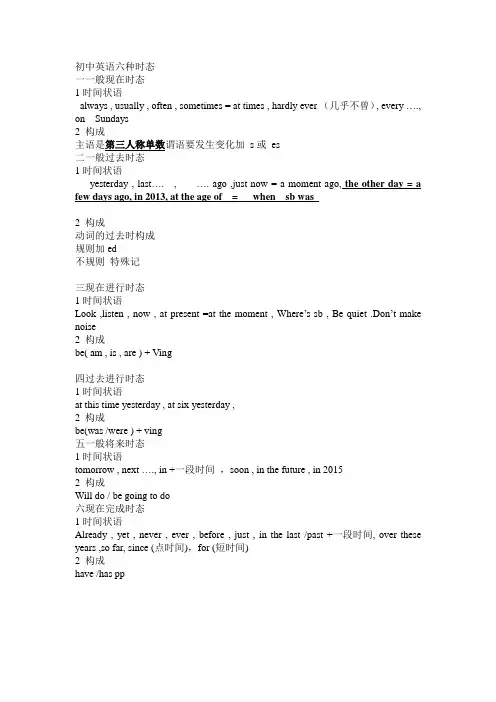
初中英语六种时态一一般现在时态1时间状语always , usually , often , sometimes = at times , hardly ever (几乎不曾), every …., on Sundays2 构成主语是第三人称单数谓语要发生变化加s或es二一般过去时态1时间状语yesterday , last…. , …. ago ,just now = a moment ago, the other day = a few days ago, in 2013, at the age of = when sb was2 构成动词的过去时构成规则加ed不规则特殊记三现在进行时态1时间状语Look ,listen , now , at present =at the moment , Where’s sb , Be quiet .Don’t make noise2 构成be( am , is , are ) + Ving四过去进行时态1时间状语at this time yesterday , at six yesterday ,2 构成be(was /were ) + ving五一般将来时态1时间状语tomorrow , next …., in +一段时间,soon , in the future , in 20152 构成Will do / be going to do六现在完成时态1时间状语Already , yet , never , ever , before , just , in the last /past +一段时间, over these years ,so far, since (点时间),for (短时间)2 构成have /has pp注意一时间状语1just现在完成时态just now = a moment ago 一般过去时态2 in the past /last 一般过去时态in a few years 一般将来时态in the last /past few years 现在完成时态3 the other day = a few years ago一般过去时态4 over (these) years现在完成时态5soon 一般将来时态6 at the age of = when sb was 一般过去时态7 so far =by now =until now 现在完成时态8 snice then现在完成时态Until then 过去完成时态二延续与非延续For /since 后面跟延续性词非延续词有完成时态I have bought a book .我买了一本书。
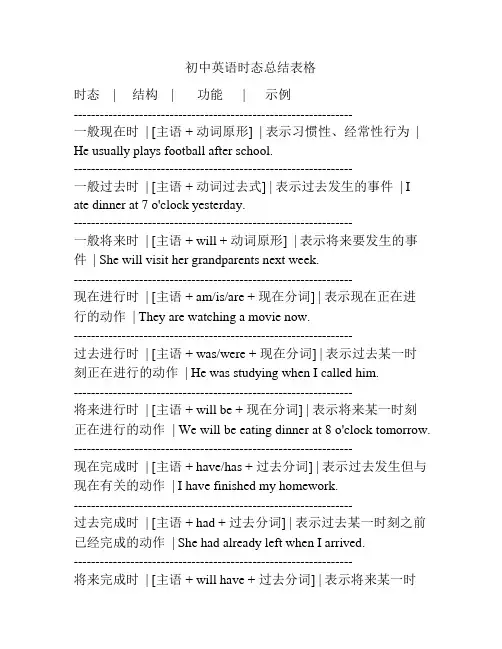
初中英语时态总结表格时态 | 结构 | 功能 | 示例----------------------------------------------------------------一般现在时 | [主语 + 动词原形] | 表示习惯性、经常性行为 | He usually plays football after school.----------------------------------------------------------------一般过去时 | [主语 + 动词过去式] | 表示过去发生的事件 | I ate dinner at 7 o'clock yesterday.----------------------------------------------------------------一般将来时 | [主语 + will + 动词原形] | 表示将来要发生的事件 | She will visit her grandparents next week.----------------------------------------------------------------现在进行时 | [主语 + am/is/are + 现在分词] | 表示现在正在进行的动作 | They are watching a movie now.----------------------------------------------------------------过去进行时 | [主语 + was/were + 现在分词] | 表示过去某一时刻正在进行的动作 | He was studying when I called him.----------------------------------------------------------------将来进行时 | [主语 + will be + 现在分词] | 表示将来某一时刻正在进行的动作 | We will be eating dinner at 8 o'clock tomorrow. ----------------------------------------------------------------现在完成时 | [主语 + have/has + 过去分词] | 表示过去发生但与现在有关的动作 | I have finished my homework.----------------------------------------------------------------过去完成时 | [主语 + had + 过去分词] | 表示过去某一时刻之前已经完成的动作 | She had already left when I arrived.----------------------------------------------------------------将来完成时 | [主语 + will have + 过去分词] | 表示将来某一时刻之前已经完成的动作 | By this time next year, we will have graduated from high school.----------------------------------------------------------------情态动词 | [情态动词 + 动词原形] | 表示能力、意愿、推测等 | She can swim very well.----------------------------------------------------------------。
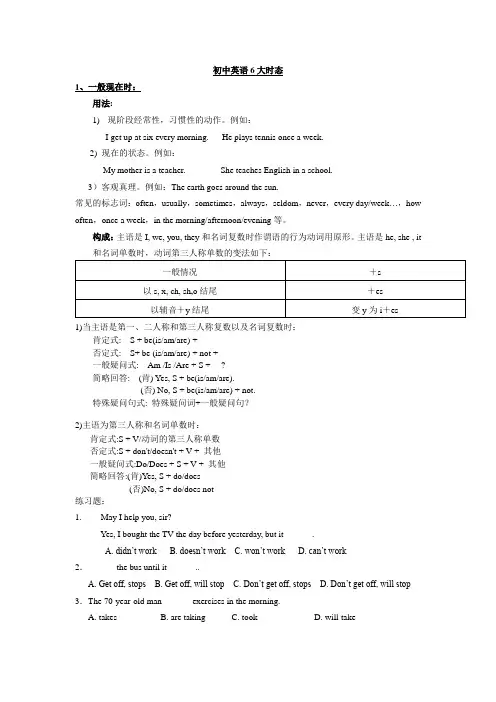
初中英语6大时态1、一般现在时:用法:1)现阶段经常性,习惯性的动作。
例如:I get up at six every morning. He plays tennis once a week.2) 现在的状态。
例如:My mother is a teacher. She teaches English in a school.3)客观真理。
例如:The earth goes around the sun.常见的标志词:often,usually,sometimes,always,seldom,never,every day/week…,how often,once a week,in the morning/afternoon/evening等。
构成:主语是I, we, you, they和名词复数时作谓语的行为动词用原形。
主语是he, she , it1)当主语是第一、二人称和第三人称复数以及名词复数时:肯定式: S + be(is/am/are) + ···否定式: S+ be (is/am/are) + not + ···一般疑问式: Am /Is /Are + S + ···?简略回答: (肯) Yes, S + be(is/am/are).(否) No, S + be(is/am/are) + not.特殊疑问句式: 特殊疑问词+一般疑问句?2)主语为第三人称和名词单数时:肯定式:S + V/动词的第三人称单数否定式:S + don't/doesn't + V + 其他一般疑问式:Do/Does + S + V + 其他简略回答:(肯)Yes, S + do/does(否)No, S + do/does not练习题:1.--- May I help you, sir?--- Yes, I bought the TV the day before yesterday, but it ______.A. didn’t workB. doesn’t workC. won’t workD. can’t work2.______ the bus until it ______..A. Get off, stopsB. Get off, will stopC. Don’t get off, stopsD. Don’t get off, will stop 3.The 70-year-old man ______ exercises in the morning.A. takesB. are takingC. tookD. will take用法:1).将要发生的动作。
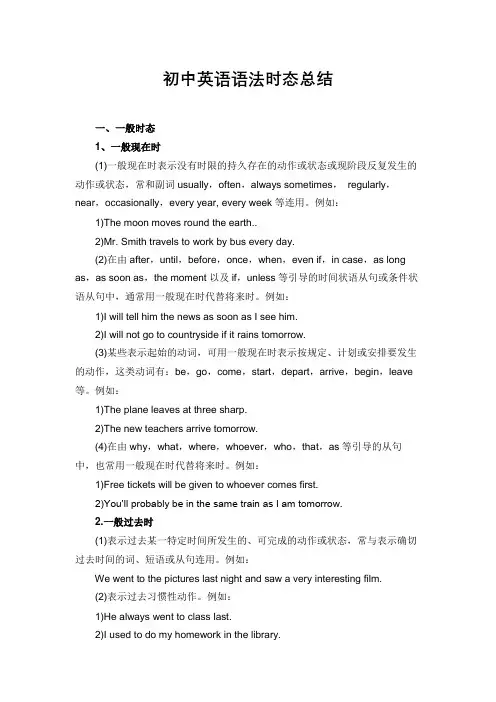
初中英语语法时态总结一、一般时态1、一般现在时(1)一般现在时表示没有时限的持久存在的动作或状态或现阶段反复发生的动作或状态,常和副词usually,often,always sometimes,regularly,near,occasionally,every year, every week等连用。
例如:1)The moon moves round the earth..2)Mr. Smith travels to work by bus every day.(2)在由after,until,before,once,when,even if,in case,as long as,as soon as,the moment以及if,unless等引导的时间状语从句或条件状语从句中,通常用一般现在时代替将来时。
例如:1)I will tell him the news as soon as I see him.2)I will not go to countryside if it rains tomorrow.(3)某些表示起始的动词,可用一般现在时表示按规定、计划或安排要发生的动作,这类动词有:be,go,come,start,depart,arrive,begin,leave 等。
例如:1)The plane leaves at three sharp.2)The new teachers arrive tomorrow.(4)在由why,what,where,whoever,who,that,as等引导的从句中,也常用一般现在时代替将来时。
例如:1)Free tickets will be given to whoever comes first.2)You’ll probably be in the same train as I am tomorrow.2.一般过去时(1)表示过去某一特定时间所发生的、可完成的动作或状态,常与表示确切过去时间的词、短语或从句连用。
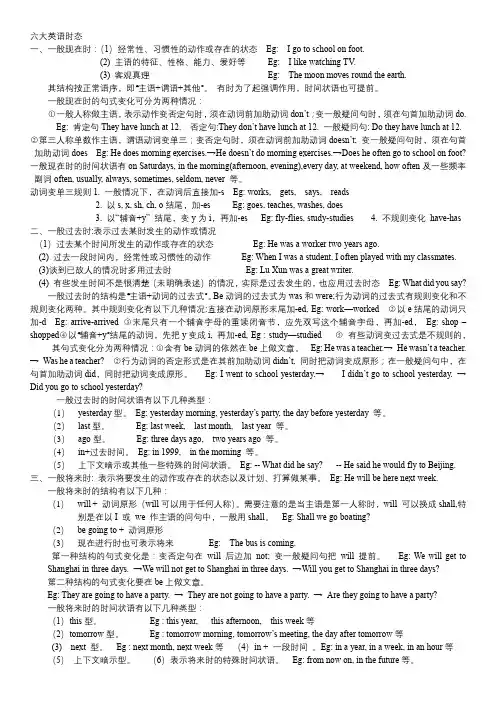
六大英语时态一、一般现在时:(1)经常性、习惯性的动作或存在的状态Eg: I go to school on foot.(2) 主语的特征、性格、能力、爱好等Eg: I like watching TV.(3) 客观真理Eg: The moon moves round the earth.其结构按正常语序,即“主语+谓语+其他”。
有时为了起强调作用,时间状语也可提前。
一般现在时的句式变化可分为两种情况:○1一般人称做主语,表示动作变否定句时,须在动词前加助动词don’t;变一般疑问句时,须在句首加助动词do.Eg: 肯定句They have lunch at 12. 否定句:They don’t have lunch at 12. 一般疑问句: Do they have lunch at 12.○2第三人称单数作主语,谓语动词变单三;变否定句时,须在动词前加助动词doesn’t; 变一般疑问句时,须在句首加助动词does Eg: He does morning exercises.→He doesn’t do morning exercises.→Does he often go to school on foot?一般现在时的时间状语有on Saturdays, in the morning(afternoon, evening),every day, at weekend, how often及一些频率副词often, usually, always, sometimes, seldom, never 等。
动词变单三规则1. 一般情况下,在动词后直接加-s Eg: works, gets, says, reads2. 以s, x, sh, ch, o结尾,加-es Eg: goes, teaches, washes, does3. 以“辅音+y” 结尾,变y为i,再加-es Eg: fly-flies, study-studies4. 不规则变化have-has二、一般过去时:表示过去某时发生的动作或情况(1)过去某个时间所发生的动作或存在的状态Eg: He was a worker two years ago.(2) 过去一段时间内,经常性或习惯性的动作Eg: When I was a student, I often played with my classmates.(3)谈到已故人的情况时多用过去时Eg: Lu Xun was a great writer.(4) 有些发生时间不是很清楚(未明确表述)的情况,实际是过去发生的,也应用过去时态Eg: What did you say?一般过去时的结构是“主语+动词的过去式”。
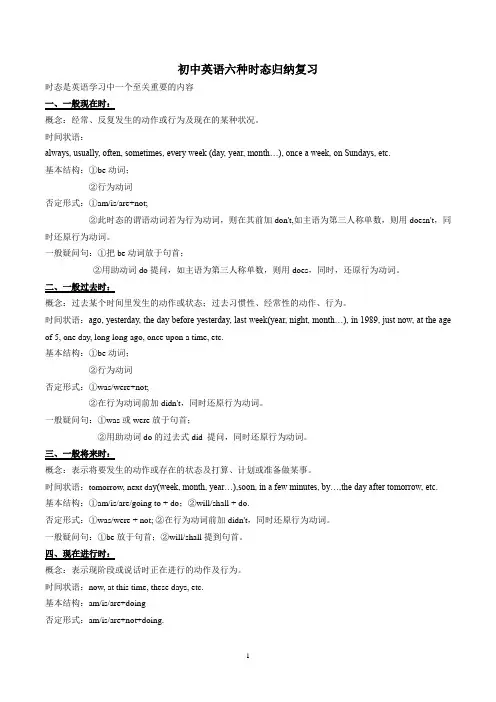
初中英语六种时态归纳复习时态是英语学习中一个至关重要的内容一、一般现在时:概念:经常、反复发生的动作或行为及现在的某种状况。
时间状语:always, usually, often, sometimes, every week (day, year, month…), once a week, on Sundays, etc.基本结构:①be动词;②行为动词否定形式:①am/is/are+not;②此时态的谓语动词若为行为动词,则在其前加don't,如主语为第三人称单数,则用doesn't,同时还原行为动词。
一般疑问句:①把be动词放于句首;②用助动词do提问,如主语为第三人称单数,则用does,同时,还原行为动词。
二、一般过去时:概念:过去某个时间里发生的动作或状态;过去习惯性、经常性的动作、行为。
时间状语:ago, yesterday, the day before yesterday, last week(year, night, month…), in 1989, just now, at the age of 5, one day, long long ago, once upon a time, etc.基本结构:①be动词;②行为动词否定形式:①was/were+not;②在行为动词前加didn't,同时还原行为动词。
一般疑问句:①was或were放于句首;②用助动词do的过去式did 提问,同时还原行为动词。
三、一般将来时:概念:表示将要发生的动作或存在的状态及打算、计划或准备做某事。
时间状语:tomorrow, next da y(week, month, year…),soon, in a few minutes, by…,the day after tomorrow, etc.基本结构:①am/is/are/going to + do;②will/shall + do.否定形式:①was/were + not; ②在行为动词前加didn't,同时还原行为动词。

六大英语时态一、一般现在时:(1)经常性、习惯性的动作或存在的状态Eg: I go to school on foot.(2) 主语的特征、性格、能力、爱好等Eg: I like watching TV.(3) 客观真理Eg: The moon moves round the earth.其结构按正常语序,即“主语+谓语+其他”。
有时为了起强调作用,时间状语也可提前。
一般现在时的句式变化可分为两种情况:○1一般人称做主语,表示动作变否定句时,须在动词前加助动词don’t;变一般疑问句时,须在句首加助动词do.Eg: 肯定句They have lunch at 12. 否定句:They don’t have lunch at 12. 一般疑问句: Do they have lunch at 12.○2第三人称单数作主语,谓语动词变单三;变否定句时,须在动词前加助动词doesn’t; 变一般疑问句时,须在句首加助动词does Eg: He does morning exercises.→He doesn’t do morning exercises.→Does he often go to school on foot?一般现在时的时间状语有on Saturdays, in the morning(afternoon, evening),every day, at weekend, how often及一些频率副词often, usually, always, sometimes, seldom, never 等。
动词变单三规则1. 一般情况下,在动词后直接加-s Eg: works, gets, says, reads2. 以s, x, sh, ch, o结尾,加-es Eg: goes, teaches, washes, does3. 以“辅音+y” 结尾,变y为i,再加-es Eg: fly-flies, study-studies4. 不规则变化have-has二、一般过去时:表示过去某时发生的动作或情况(1)过去某个时间所发生的动作或存在的状态Eg: He was a worker two years ago.(2) 过去一段时间内,经常性或习惯性的动作Eg: When I was a student, I often played with my classmates.(3)谈到已故人的情况时多用过去时Eg: Lu Xun was a great writer.(4) 有些发生时间不是很清楚(未明确表述)的情况,实际是过去发生的,也应用过去时态Eg: What did you say?一般过去时的结构是“主语+动词的过去式”。
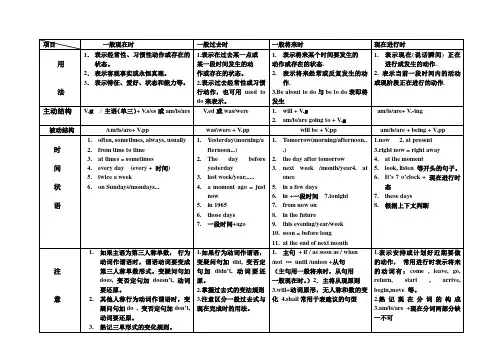

初中英语语法总结动词的六种时态动词有六种时态:一般现在时、一般过去时、一般将来时、现在进行时、过去进行时和将来进行时。
1. 一般现在时(Simple Present Tense):表示目前的状态、习惯、经常发生的事情或普遍真理。
-肯定句:主语+动词原形(第三人称单数形式加-s)- 否定句:主语+do(does)+not+动词原形- 疑问句:Do(Does)+主语+动词原形?2. 一般过去时(Simple Past Tense):表示过去发生的动作或状态。
-肯定句:主语+动词过去式- 否定句:主语+did+not+动词原形- 疑问句:Did+主语+动词原形?3. 一般将来时(Simple Future Tense):表示将来要发生的动作或情况。
- 肯定句:主语+will+动词原形- 否定句:主语+will+not+动词原形- 疑问句:Will+主语+动词原形?4. 现在进行时(Present Continuous Tense):表示当前正在进行的动作或情况。
- 肯定句:主语+am/is/are+动词-ing形式- 否定句:主语+am/is/are+not+动词-ing形式- 疑问句:Am/Is/Are+主语+动词-ing形式?5. 过去进行时(Past Continuous Tense):表示过去一些时间点正在进行的动作或情况。
- 肯定句:主语+was/were+动词-ing形式- 否定句:主语+was/were+not+动词-ing形式- 疑问句:Was/Were+主语+动词-ing形式?6. 将来进行时(Future Continuous Tense):表示将来一些时间点会继续进行的动作或情况。
- 肯定句:主语+will be+动词-ing形式- 否定句:主语+will not be+动词-ing形式- 疑问句:Will+主语+be+动词-ing形式?注意:动词的时态变化仅针对于一般动词,对于助动词、情态动词和不规则动词,变化规则可能会有所不同。
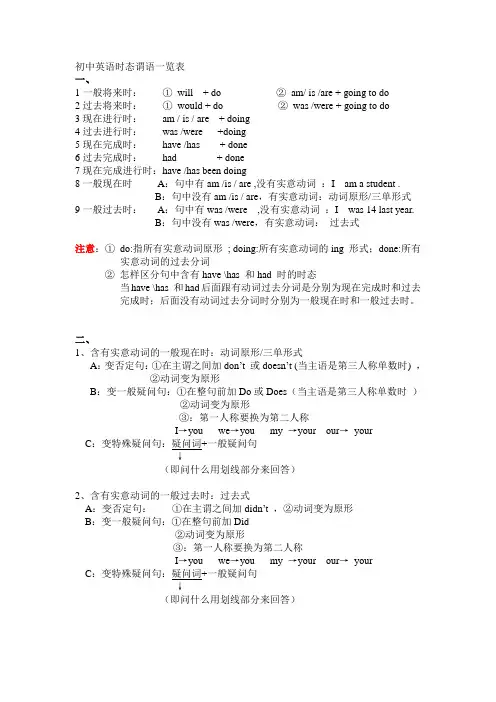
初中英语时态谓语一览表一、1一般将来时:①will + do ②am/ is /are + going to do2过去将来时:①would + do ②was /were + going to do3现在进行时:am / is / are + doing4过去进行时:was /were +doing5现在完成时:have /has + done6过去完成时:had + done7现在完成进行时:have /has been doing8一般现在时A:句中有am /is / are ,没有实意动词:I am a student .B:句中没有am /is / are,有实意动词:动词原形/三单形式9一般过去时:A:句中有was /were ,没有实意动词:I was 14 last year.B:句中没有was /were,有实意动词:过去式注意:①do:指所有实意动词原形; doing:所有实意动词的ing 形式;done:所有实意动词的过去分词②怎样区分句中含有have \has 和had 时的时态当have \has 和had后面跟有动词过去分词是分别为现在完成时和过去完成时;后面没有动词过去分词时分别为一般现在时和一般过去时。
二、1、含有实意动词的一般现在时:动词原形/三单形式A:变否定句:①在主谓之间加don’t 或doesn’t (当主语是第三人称单数时) ,②动词变为原形B:变一般疑问句:①在整句前加Do或Does(当主语是第三人称单数时)②动词变为原形③:第一人称要换为第二人称I→you we→you my →your our→yourC:变特殊疑问句:疑问词+一般疑问句↓(即问什么用划线部分来回答)2、含有实意动词的一般过去时:过去式A:变否定句:①在主谓之间加didn’t ,②动词变为原形B:变一般疑问句:①在整句前加Did②动词变为原形③:第一人称要换为第二人称I→you we→you my →your our→yourC:变特殊疑问句:疑问词+一般疑问句↓(即问什么用划线部分来回答)。
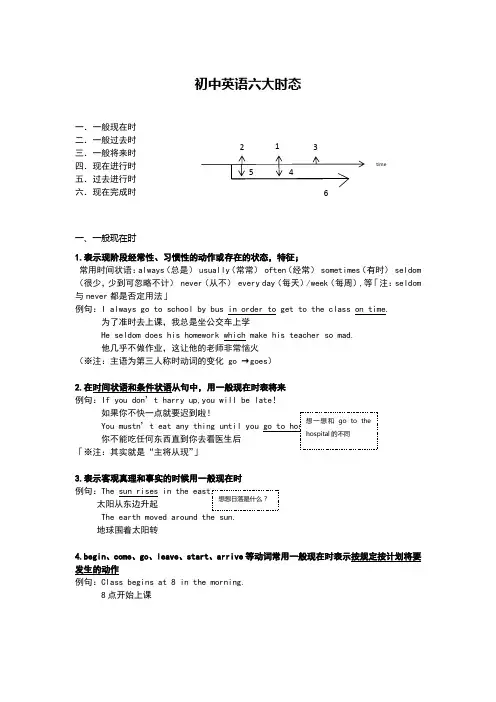
初中英语六大时态一.一般现在时二.一般过去时三.一般将来时四.现在进行时五.过去进行时六.现在完成时一、一般现在时1.表示现阶段经常性、习惯性的动作或存在的状态,特征;常用时间状语:always (总是) usually (常常) often (经常) sometimes (有时) seldom (很少,少到可忽略不计) never (从不) every day (每天)/week (每周),等「注:seldom 与never 都是否定用法」例句:I always go to school by bus in order to get to the class on time.为了准时去上课,我总是坐公交车上学 He seldom does his homework which make his teacher so mad.他几乎不做作业,这让他的老师非常恼火(※注:主语为第三人称时动词的变化 go →goes )2.在时间状语和条件状语从句中,用一般现在时表将来例句:If you don ’t harry up,you will be late !time 2 1 3如果你不快一点就要迟到啦!You mustn’t eat any thing until you go to hospital.你不能吃任何东西直到你去看医生后「※注:其实就是“主将从现”」3.表示客观真理和事实的时候用一般现在时例句:The sun rises in the east.太阳从东边升起The earth moved around the sun.地球围着太阳转4.begin、come、go、leave、start、arrive等动词常用一般现在时表示按规定按计划将要发生的动作例句:Class begins at 8 in the morning.8点开始上课二、一般过去时1.一般过去时表示过去某时间发生的动作、存在的状态或过去反复发生的动作。
初中英语6大时态初中英语时态是英语语法中的重要部分,也是学习英语的基础之一。
以下是初中英语常见的六大时态:一、现在进行时现在进行时表示现在正在进行的动作或存在的状态。
其构成形式是be动词(am/is/are)+动词的现在分词形式。
例如:I am studying now. 我正在学习。
二、过去进行时过去进行时表示过去某一时刻正在进行的动作或存在的状态。
其构成形式是be动词的过去式(was/were)+动词的现在分词形式。
例如:We were watching TV at 8 o'clock yesterday evening. 昨天晚上八点钟我们在看电视。
三、一般现在时一般现在时表示通常或反复发生的动作或存在的状态。
其构成形式是主语+动词+(宾语)。
例如:We go to school every morning. 我们每天早上都去上学。
四、一般过去时一般过去时表示过去某个时间发生的动作或存在的状态。
其构成形式是主语+动词的过去式+(宾语)。
例如:We went to the park yesterday. 昨天我们去了公园。
五、一般将来时一般将来时表示将来要发生的动作或存在的状态。
其构成形式是主语+will/shall+动词原形+(宾语)。
例如:We will finish our homework tomorrow. 我们明天将完成我们的作业。
六、过去将来时过去将来时表示过去某一时刻将要发生的动作或存在的状态。
其构成形式是主语+would+动词原形+(宾语)。
例如:He said he would come to see me the next day. 他说他第二天会来看我。
初中英语所有时态1.一般现在时(do/does; is/am/are)①表示现在的情况、状态或特征。
例:He is a student.他是一个学生。
②表示经常性、习惯性动作。
例:He always helps others.他总是帮助别人。
③客观事实和普遍真理。
例:The earth moves the sun.地球绕着太阳转。
④表示一个按规定、计划或安排要发生的动作。
仅限于某些表示“来、去、动、停、开始、结束、继续”等的动词,可以与表示未来时间的状语搭配使用。
常见的用法是:飞机、火车、轮船、汽车等定期定点运行的交通方式。
例:The next train leaves at 3 o'clock this afternoon.下一趟火车今天下午3点开车。
⑤在时间、条件和让步状语从句中经常用一般现在(有时也用现在完成时)表示将的来事情。
(即:主将从现原则)例:I will call you as soon as I arrive at the airport.我一到机场就会给你打电话。
When you have finished the report, I will have waited for about 3 hours.等你完成这份报告的时候,我就已经等了将近3个小时了。
2. 现在进行时(am/is/are doing)①表示此时此刻正在发生的事情。
例:He is listning to the music now.他现在正在听音乐。
②表示目前一段时间内一直在做的事情,但不一定此时此刻正在做。
例:I am studying computer this term.这个学期我一直在学习计算机。
③现在进行时可以表示将来的含义。
瞬时动词的进行一定表将来。
例:I am leaving.我要离开了。
持续动词的进行只有有将来的时间状语或有将来语境中才表将来。
例:I am travelling next month.下个月我要去旅行。
六种时态一览表时态一般现在时一般过去时现在进行时过去进行时一般将来时现在完成时用法时间标志构成方式表示常性生的表示去某个表示在或段正表示去某正在表示将来某个要作、性作或客生的作或存在的状在行或生的行的作或存在的状生的作或存在的真理、科学事等。
作。
状。
度副: always,the day before now, at the moment, at just then,at this tomorrow ; the dayoften , usually ,yesterday,yesterday,this moment, just moment yesterday, after tomorrow;nextsometimes,seldom,last/yesterday night,now,look, listen, at yesterday morning/day/week/month/year/never;everyday,every last week, last month,present, these days,afternoon/evening, at term; soon; in a fewweek, every month, last year,last term;this week that time,this minutes; by+ 年份 ;every year 等in/on+ 去 ;morning,the whole in+状; in the+ago; just now, at the morning,all day future; in futureage of 5, one day, long yesterday, from+long ago; once upon a数 +to+数+lasttime night, those days 或以when, while 引的是一般去的状等。
六种时态一览表时态一般现在时一般过去时现在进行时过去进行时一般将来时现在完成时用法时间标志构成方式表示经常性发生的动表示过去某个时间发表示现在或现阶段正表示过去某时正在进表示将来某个时间要作、习惯性动作或客生的动作或存在的状在进行或发生的动行的动作或存在的状发生的动作或存在的观真理、科学事实等。
态。
作。
态。
状态。
频度副词: always,the day before now, at the moment, at just then,at this tomorrow ; the dayoften , usually ,yesterday,yesterday,this moment, just moment yesterday, after tomorrow;nextsometimes,seldom,last/yesterday night,now,look, listen, at yesterday morning/day/week/month/year/never;everyday,every last week, last month,present, these days,afternoon/evening, at term; soon; in a fewweek, every month, last year,last term;this week that time,this minutes; by+ 年份 ;every year 等in/on+ 过去时间 ;时间morning,the whole in+时间状语; in the+ago; just now, at the morning,all day future; in futureage of 5, one day, long yesterday, from+ 时间long ago; once upon a数 +to+ 时间数 +lasttime night, those days 或以when, while 引导的谓语动词是一般过去时的时间状语等。
初中英语时态一览表以下是初中英语主要时态的一览表:1. 现在一般时:I eat an apple every day.2. 过去一般时:She studied English last year.3. 现在进行时:They are playing basketball now.4. 过去进行时:They were having dinner at this time yesterday.5. 现在完成时:I have finished my homework.6. 过去完成时:They had learned 2000 English words by the end of last year.7. 现在完成进行时:We have been waiting for you for half an hour.8. 过去完成进行时:We had been learning English for 3 years by the end of last year.9. 将来一般时:She will visit her grandparents next week.10. 将来进行时:They will be having a meeting tomorrow.11. 将来完成时:They will have finished their work by the end of this week.12. 过去将来一般时:He said he would go to the library the next day.13. 过去将来进行时:He said he would be working on his project over the weekend.14. 过去将来完成时:He said he would have written the report by the end of the month.希望这个一览表能帮到你!如果你还有其他问题,请随时提问。
初中英语六大基本时态汇总1一般现在时一般现在时的形式为:主语+be动词(am/is/are)+其他主语+实义动词(动词原形/第三人称单数形式)+其他实义动词的第三人称单数形式变化形式如下:大多数动词在此为直接-s。
例如:start→starts;open→opens等。
以-ch、-sh、-s、-x、-o结尾的词后加-es。
例如:do→does;fix→fixes 等。
以辅音字母加-y结尾的动词,把y变-i,再加es。
例如study→studies。
一般现在时经常与always、usually、often、sometimes、never、every day/month/year/time、once a day/month/year等表示时间或频度的状语连用。
1)表示现在经常性或习惯性的动作或活动My mother likes getting up early.我妈妈喜欢早起。
2)表示重复性的行为I talk to my mother three times a day!我每天跟妈妈有三次谈话!3)表示永恒真理或永久性现象The sun rises in the east.太阳从东方升起。
4)表示一般性事实He enjoys painting.他喜欢绘画。
5)表示将来明确的日程安排或计划要做的事,常用的这类动词有arrive, begin, close等The show begins at 11 a.m.演出上午11点开始。
2一般过去时一般过去时中的动词需要变为过去式。
英语中大多数动词为规则动词,过去式由动词原形加-ed(以-e结尾的词加-d)构成;以辅音字母加-y结尾的词,把-y变为-i,再加-ed,以元音字母加-y结尾的词,直接在-y后加-ed;以一个辅音字母结尾的重读闭音节词需要双写词尾的辅音字母后再加-ed。
不规则动词变化需要特别记忆。
1)表示在过去某一时间的活动或状态,开始和结束的时间都在过去This town was a beautiful spot ten years ago.十年前这个小镇是个美丽的地方。